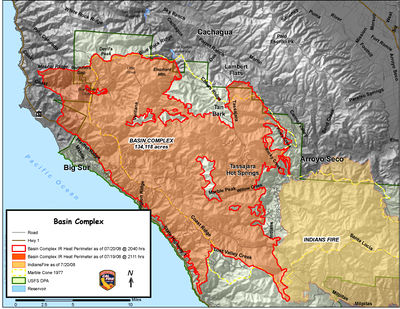Basin-Indians Wildfire in California's Central Coast Region
A watershed-related issue examined by the ENVS 560/L Watershed Systems class at CSUMB.

Contents
Summary
In the summer of 2008, the Indians and Basin Complex fires started separately and then merged into one fire. The Indians fire, started by a campfire, burned 81,378 acres of the south eastern Santa Lucia mountains of Central California between June 8th and July 10th. The Basin Complex Fire, started by lightning, burned 162,818 acres of the northern Santa Lucia mountains between June 21st and July 28th[1]. After a wildfire there is major concern about the possibility of flooding, debris flows and other large scale erosion in the years following the fires[2]. These events potentially endanger the Big Sur and Carmel Valleys, Salinas farm land, steelhead habitat, Highway 1 and numerous federal and state recreation areas. There has been work aimed at understanding the effects of fire on soils, debris flows and erosion. There is little understanding of the effects of post-fire erosion and debris flows on river habitat, and specifically steelhead habitat.
Location
The Basin Complex-Indians Fire burned approximately 240,000 acres in the northern Santa Lucia Mountains. The fire burned parts of the Upper Carmel River, Arroyo Seco, San Antonia, Rat Creek, Big Sur and Little Sur watersheds. and portions of Fort Hunter Liggett. Much of the land burned is within the National Forest System lands on the Monterey District of Los Padres National Forest[1].
Resource/s at Stake
There is a broad range of resources at risk after wildfires. Risks related to the Basin Complex Fire included: Big Sur and Carmel Valley communities, Salinas Valley farm land, Highway 1, numerous state parks and camp grounds, private residents and essential steelhead salmon habitat.
Stakeholders
- The communities of Big Sur and Carmel Valley
- Salinas Valley farmers
- Steelhead trout and those concerned with their well being
- Monterey County
- United States Forest Service
- Users of Highway 1
Jurisdiction
Assessment of the burned area fell under the jurisdiction of the US Forest Service and California Forestry and Fire Protection (CalFire). CalFire was the lead agency for the assessment. The policies of both agencies are to provide rapid assessments of the burned areas and suggest best management practices to avoid further damage from erosion and debris flows.
Future Research
Future work should seek to understand the impacts of rain on the burned area. The greatest hazards to the communities of Big Sur is flooding and debris flows. The in stream habitats of threatened steelhead will also be effected by erosion and debris flows. There is little understanding of the direct effects of post-fire erosion on steelhead habitat.
References
- Basin Complex Fire Seat Report
- Ten Year Comprehensive Strategy
Links
- Impact of fires in California's Central Coast Region
- Other Watershed Issues
- Soberanes Fire
- Zaca Fire
- Kirk Complex Fire
- Painted Cave Fire
- Rat Creek - Gorda Complex Fire
- Marble Cone Fire
- Santa Ana winds
- California Department of Fish and Wildlife (CDFW)
- California Chaparral
- Oak Woodlands of California's Central Coast Region
- Coast Redwood (Sequoia sempervirens)
- California's Central Coast Region
- United States Forest Service (USFS)
- California Department of Forestry and Fire Protection (CalFire)
- California Department of Parks and Recreation
- United States Bureau of Land Management (BLM)
- California Department of Fish and Wildlife (CDFW)
Disclaimer
This page may contain students' work completed as part of assigned coursework. It may not be accurate. It does not necessarily reflect the opinion or policy of CSUMB, its staff, or students.